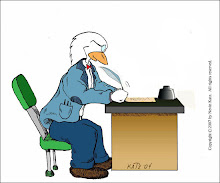So what's up with these talking birds? And where did we all come from? I've been working tirelessly to trace back my family tree but the details remain shrouded in mystery. According to the tree I've reconstructed, I am a 3rd generation bird immigrant. My family came to America from the Galapagos Islands in the early 20th century. According to some scientists' journals I got ahold of, the first species of talking birds were discovered on the Galapagos Islands many generations ago...before the days of Charles Darwin. Scientists found some odd-shaped eggs that were unlike any they had seen before. They observed these eggs day after day, and ultimately they hatched. Upon seeing these eggs they found that the baby birds that hatched from them possessed an odd humanoid limb structure, and that their intelligence was abnormally high. Knowing that these birds would be experimented upon mercilessly if they were discovered, the scientists took them into the caves and began teaching them on their own. Over several centuries, these birds developed their own culture and language, which remained confined to the islands for quite some time. While initially tribal, it became sophisticated and civilized over many generations. Some of our kind made it to Europe and worked with great scientists as apprentices, such as Theodor Schwann, Alfred Wegener, and Robert Hooke. Of course, none of this showed up in the journals. Scientists held clandestine meetings about these mysterious birds but did not make them known to the larger world.
Genetics. Essentially we are viewed as the next step in bird evolution. Geneticists have of course taken to our genomes with great enthusiasm. Upon comparing our DNA with those of common birds, they have found that a latent DNA sequences, which were primarily written off as "junk" DNA in other birds, were made active by a mutation. This mutation most likely was a promoter sequence combined with start and stop codons that "switched on" these inactive sequences in our species. The activated sequences then activated new neural pathways and developmental patterns which caused us to become more human-like. That is the recent theory, anyways. But the question still remains: where did these sequences come from? Scientists maintain that our ancestors' genomes recieved human-like DNA from viruses, which integrated their DNA into ours. This theory has yet to be developed, however.
Culture. It was not until recent decades that the talking bird species have been integrated into society. We were granted human status about a decade ago, and have since been able to partake in larger society. While many of us were concerned about how society would respond, humanity has for the most part been welcoming. Why is this the case? Some explain this through karma: almost without fail, anyone who has tried to do wrong to a talking bird has come upon severe misfortune. For example, a fellow who tries to mug a talking bird almost invariably comes down with the severe flu in 24 hours. Other explanations include how people respond to talking birds. Because we resemble cartoon characters from childhood, people tend to respond well to that. That is all I have to say for now about the species of talking birds that exist today. More information as it develops. - Dr. B
Subscribe to:
Post Comments (Atom)

1 comment:
Hmmm... that's a lot of speculative assertions. How do we know some intelligent designer didn't just plunk those eggs down there? Is there any fossil record of intermediary forms? Can such extreme mutations work so suddenly, in a single generation?
My cats urge me not to listen to such scientific mumbo-jumbo. They insist that birds, ALL birds, were created in order to provide them (the cats) with food, entertainment, and ammunition for barfing on dry-clean-only rugs.
Whom can I believe?
Post a Comment